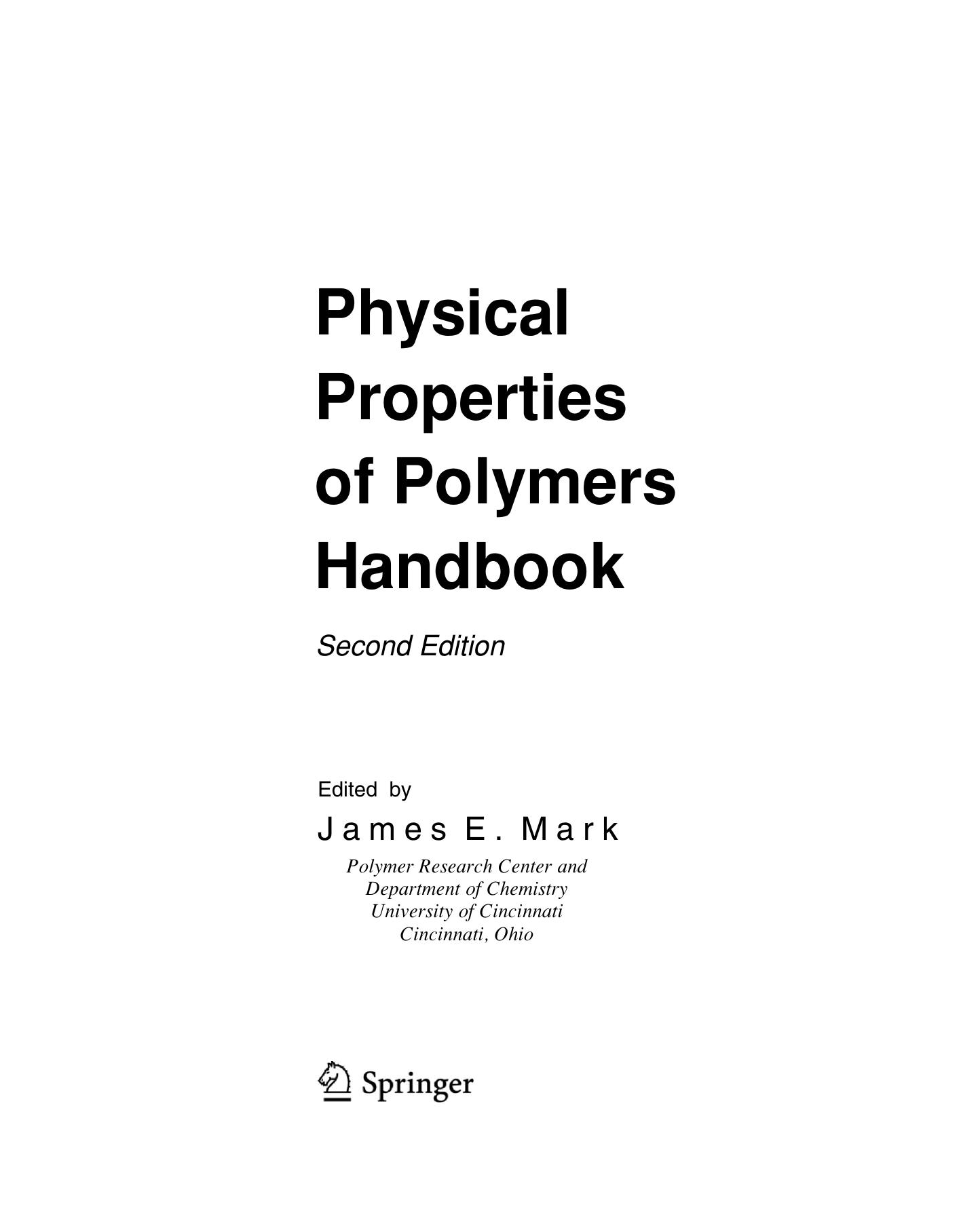
书籍简介
本书pdf是文字版。
Structure
1.1 Chain Structures
1.2 Names, Acronyms, Classes, and Structures of Some Important Polymers
Theory
2.1 The Rotational Isomeric State Model
2.2 Computational Parameters
2.3 Theoretical Models and Simulations of Polymer Chains
2.4 Scaling, Exponents, and Fractal Dimensions
Thermodynamic Properties
3.1 Densities, Coefficients of Thermal Expansion, and Compressibilities of Amorphous Polymers
3.2 Thermodynamic Properties of Proteins
3.3 Heat Capacities of Polymers
3.4 Thermal Conductivity
3.5 Thermodynamic Quantities Governing Melting
3.6 The Glass Temperature
3.7 Sub-Tg Transitions
3.8 Polymer—Solvent Interaction Parameter $\chi$
3.9 Theta Temperatures
3.10 Solubility Parameters
3.11 Mark—Houwink—Staudinger—Sakurada Constants
3.12 Polymers and Supercritical Fluids
3.13 Thermodynamics of Polymer Blends
Spectroscopy
4.1 NMR Spectroscopy of Polymers
4.2 Broadband Dielectric Spectroscopy to Study the Molecular Dynamics of Polymers Having Different Molecular Architectures
4.3 Group Frequency Assignments for Major Infrared Bands Observed in Common Synthetic Polymers
4.4 Small Angle Neutron and X-Ray Scattering
Mechanical Properties
5.1 Mechanical Properties
5.2 Chain Dimensions and Entanglement Spacings
5.3 Temperature Dependences of the Viscoelastic Response of Polymer Systems
5.4 Adhesives
5.5 Some Mechanical Properties of Typical Polymer-Based Composites
5.6 Polymer Networks and Gels
5.7 Force Spectroscopy of Polymers: Beyond Single Chain Mechanics
Reinforcing Phases
6.1 Carbon Black
6.2 Properties of Polymers Reinforced with Silica
6.3 Physical Properties of Polymer/Clay Nanocomposites
6.4 Polyhedral Oligomeric Silsesquioxane (POSS)
6.5 Carbon Nanotube Polymer Composites: Recent Developments in Mechanical Properties
6.6 Reinforcement Theories
Crystallinity and Morphology
7.1 Densities of Amorphous and Crystalline Polymers
7.2 Unit Cell Information on Some Important Polymers
7.3 Crystallization Kinetics of Polymers
7.4 Block Copolymer Melts
7.5 Polymer Liquid Crystals and Their Blends
7.6 The Emergence of a New Macromolecular Architecture: “The Dendritic State”
7.7 Polyrotaxanes
7.8 Foldamers: Nanoscale Shape Control at the Interface Between Small Molecules and High Polymers
7.9 Recent Advances in Supramolecular Polymers
Electrical, Optical and Magnetic Properties
8.1 Conducting Polymers: Electrical Conductivity
8.2 Electroluminescent Polymer Systems
8.3 Magnetic, Piezoelectric, Pyroelectric, and Ferroelectric Properties of Synthetic and Biological Polymers
8.4 Nonlinear Optical Properties of Polymers
8.5 Refractive Index, Stress-Optical Coefficient, and Optical Configuration Parameter of Polymers
Responses to Radiation, Heat, and Chemical Agents
9.1 Ultraviolet Radiation and Polymers
9.2 The Effects of Electron Beam and $\gamma$-Irradiation on Polymeric Materials
9.3 Flammability
9.4 Thermal-Oxidative Stability and Degradation of Polymers
9.5 Synthetic Biodegradable Polymers for Medical Applications
9.6 Biodegradability of Polymers
9.7 Properties of Photoresist Polymers
9.8 Pyrolyzability of Preceramic Polymers
Other Properties
10.1 Surface and Interfacial Properties
10.2 Acoustic Properties of Polymers
10.3 Permeability of Polymers to Gases and Vapors
Miscellaneous
11.1 Definitions
11.2 Units and Conversion Factors
Comments !